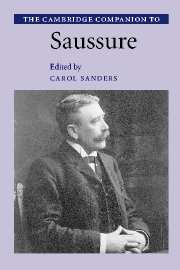Book contents
- Frontmatter
- Introduction: Saussure today
- Part I Out of the nineteenth century
- Part II The ‘Course in General Linguistics’
- Part III After the Cours
- Part IV New debates and directions
- 13 Saussure’s unfinished semantics
- 14 Saussure, linguistic theory and philosophy of science
- 15 Saussure’s legacy in semiotics
- Notes
- Works by Saussure and further reading
- References
- Index
15 - Saussure’s legacy in semiotics
from Part IV - New debates and directions
Published online by Cambridge University Press: 28 May 2006
- Frontmatter
- Introduction: Saussure today
- Part I Out of the nineteenth century
- Part II The ‘Course in General Linguistics’
- Part III After the Cours
- Part IV New debates and directions
- 13 Saussure’s unfinished semantics
- 14 Saussure, linguistic theory and philosophy of science
- 15 Saussure’s legacy in semiotics
- Notes
- Works by Saussure and further reading
- References
- Index
Summary
While the abstract notion of 'sign' has been intensively discussed in western philosophy at least since Plato and the Stoics (e.g. Manetti, 1993), a special theoretical domain devoted to the general study of signs did not emerge until the beginning of the twentieth century. As it emancipated itself from its philosophical cradle, this new kind of inquiry became variously known as 'semeiotic', 'semiotic', 'significs' (Peirce, 1977), 'semiology', 'signology' (Saussure, 1916) and 'semiotics' (Sebeok, 1976). What all these terms have in common is that they are coined from the ancient Greek word for 'sign': semeion and its Latin equivalent signum. Their etymology and terminological history is well documented (e.g. Sebeok, 1976; Moeller and Wulff, 1985; Bouissac, 1998).
During the second half of the twentieth century, 'semiotics' was increasingly accepted as referring to the branch of knowledge concerned with formal and empirical research on signs, signification, meaning and communication. It competed with the term 'semiology' (translated from the French sémiologie). Both semiotics and semiology are now used with more or less the same broad value, unless specified otherwise, and cover a great variety of schools each with its own theoretical and methodological approach. However, 'semiotics' tends to evoke the writings of American philosopher Charles Sanders Peirce (1839-1914) while 'semiology' sometimes exclusively refers to the traditions derived from the teaching of Swiss linguist Ferdinand de Saussure (1857-1913), principally in the Gallic context. Peirce and Saussure are indeed generally considered as the two initiators of the modern 'science of signs' for which they independently sketched tentative definitions and research blueprints. However, while Peirce was a prolific writer who produced many versions of his theoretical vision, Saussure did not publish any work on this topic in his lifetime and he communicated his ideas exclusively through his teaching and correspondence. These ideas were summarised and edited by two of his colleagues posthumously.
- Type
- Chapter
- Information
- The Cambridge Companion to Saussure , pp. 240 - 260Publisher: Cambridge University PressPrint publication year: 2004
- 3
- Cited by



